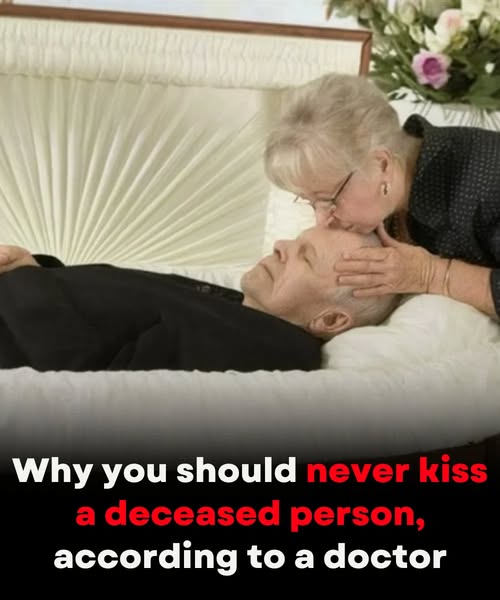The Debate Surrounding Kissing the Deceased: A Health-Based Perspective
In a world where health concerns and traditional customs often collide, the topic of kissing deceased loved ones has ignited a heated discussion. Recently, Dr. Viktor Ivanovik, a physician from Moldova with a substantial following of over 300,000 on TikTok, took to the platform to address this sensitive subject. His warning about the potential health risks associated with such practices has triggered both support and criticism from various corners of society. While the act of kissing a loved one as a final farewell may seem like a natural expression of grief, the implications of doing so are more complex than they appear.
A Cautionary Tale of Health Risks
In his viral video, Dr. Ivanovik emphasized that while the risk of transmitting infections after death is relatively rare, it is not entirely absent. The physician pointed out that individuals who have passed away from infectious diseases, such as tuberculosis, hepatitis, or even certain strains of flu, could pose a health hazard if physical contact is made. This assertion, though grounded in medical understanding, has fueled a broader debate about the balance between preserving health and honoring age-old mourning traditions. In particular, Dr. Ivanovik’s comments have resonated with families who have faced the loss of loved ones during health crises, such as the COVID-19 pandemic.
Traditions of Mourning Across Cultures
Throughout history, the act of touching or kissing the deceased has held significant meaning in numerous cultures. For example, in many African cultures, the body of the deceased is often washed and dressed for the funeral, with family members sometimes kissing the forehead or holding the hand of their loved one. This practice not only signifies a final farewell but is also deeply rooted in the belief that the spirit of the deceased remains connected to their physical body for a period after death. Similarly, in certain Asian cultures, rituals involving the deceased are seen as an essential component in the grieving process, providing a sense of closure and connection that aids in healing.
Health Guidelines During Pandemics
During health crises such as the COVID-19 pandemic, health officials have often recommended against physical contact with the deceased, not out of a desire to dismantle cultural practices, but to mitigate risk. The rationale behind these precautions is to protect the living from potential health threats. Medical professionals commonly acknowledge that while the risk of contracting diseases from deceased individuals is generally low when the cause of death is non-infectious, those who succumb to serious infections may indeed pose a danger. For instance, during the pandemic, guidelines suggested that alternative methods of saying goodbye should be considered, including virtual memorial services and drive-by visitations, allowing people to express their grief safely.
Professional Guidance on Post-Mortem Contact
In light of the complexities involved, experts recommend that individuals consult with healthcare providers or funeral directors if they are uncertain about the safety of post-mortem contact. Tailored advice can help individuals navigate their grief while maintaining awareness of health risks. Funeral directors often serve as valuable resources for families, providing information about potential health hazards and suggesting safer alternatives to traditional practices. Moreover, understanding the medical guidelines in place can empower families to make informed choices that honor their loved ones while prioritizing health.
Alternatives to Physical Contact
For those seeking ways to express their grief without physical contact, various alternatives exist that honor the memory of the deceased while preserving safety. Some meaningful options include:
- Placing a flower on the body or grave, symbolizing love and remembrance.
- Lighting a candle in their honor, creating a serene atmosphere for reflection.
- Writing a heartfelt farewell letter, expressing emotions that may be challenging to verbalize.
- Creating a tribute featuring photos and music that captures the essence of the departed.
These rituals, which carry emotional weight, allow individuals to navigate their grief in a manner that minimizes health risks while still honoring their loved ones. Such alternatives embody the intention of farewell—rooted in love, respect, and remembrance—while adapting to the realities of modern health concerns. The transition from physical contact to symbolic gestures may also encourage a deeper reflection on the nature of grief and mourning.
The Intersection of Tradition and Health
This ongoing discourse around kissing the deceased reflects a broader societal issue—how we reconcile cherished traditions with modern health considerations. As more people become aware of potential risks, a shift in how we engage with our mourning rituals may emerge. Striking a balance between honoring our cultural practices and ensuring the health and safety of our community is crucial. Societies are beginning to explore how to integrate health education into funeral practices, allowing individuals to express their grief meaningfully while considering the implications of their actions.
In conclusion, the topic of kissing deceased loved ones invites a complex interplay of tradition, emotion, and health awareness. While the desire to maintain our customs is strong, it is essential to make informed decisions that honor both our loved ones and our own well-being. As society navigates these issues, the conversation will likely continue to evolve, blending respect for tradition with an understanding of health risks. This nuanced dialogue not only deepens our understanding of grief but also encourages a more mindful approach to how we say goodbye, ultimately preserving the emotional significance of our customs while adapting to the realities of modern health care.

















